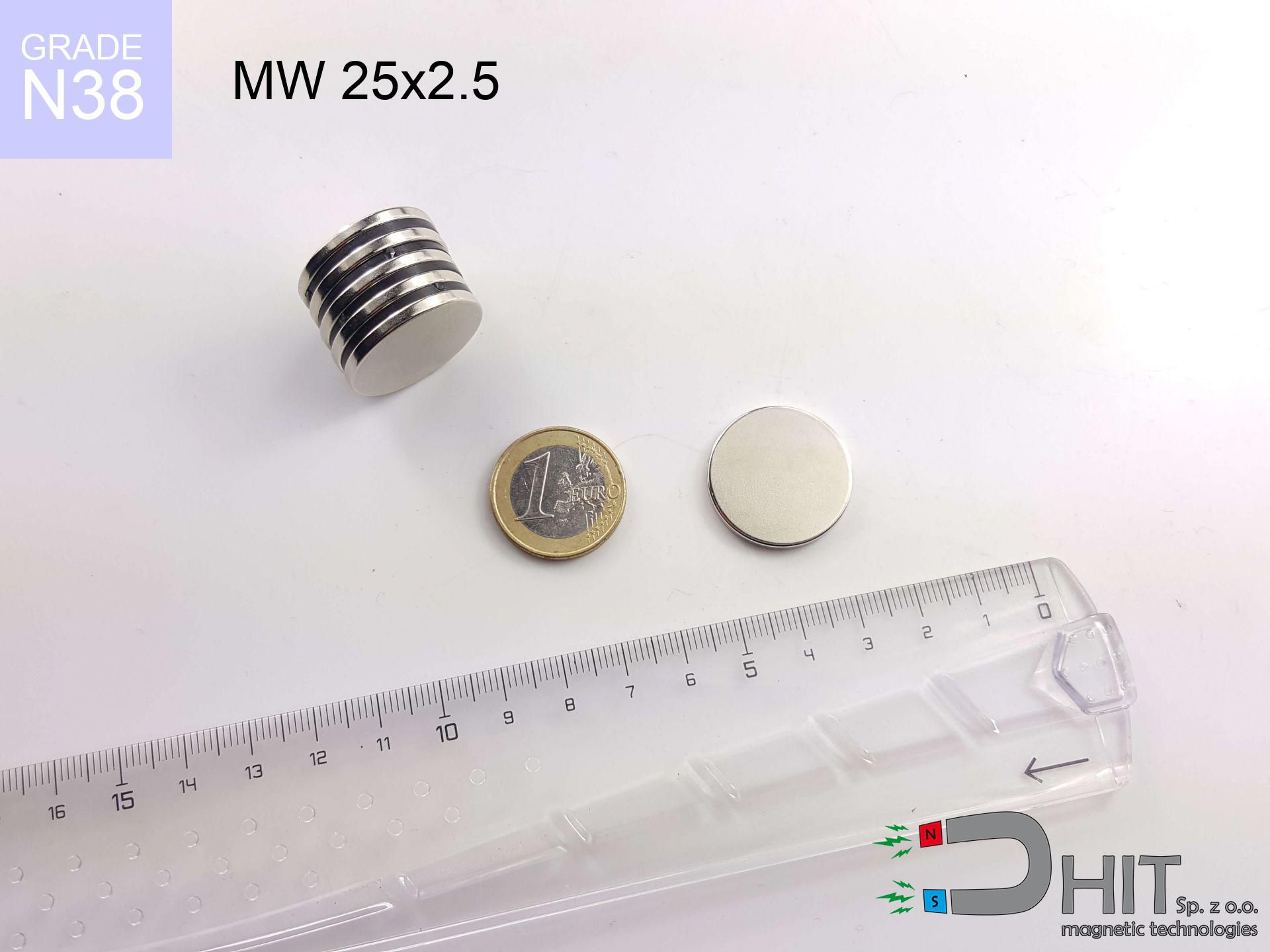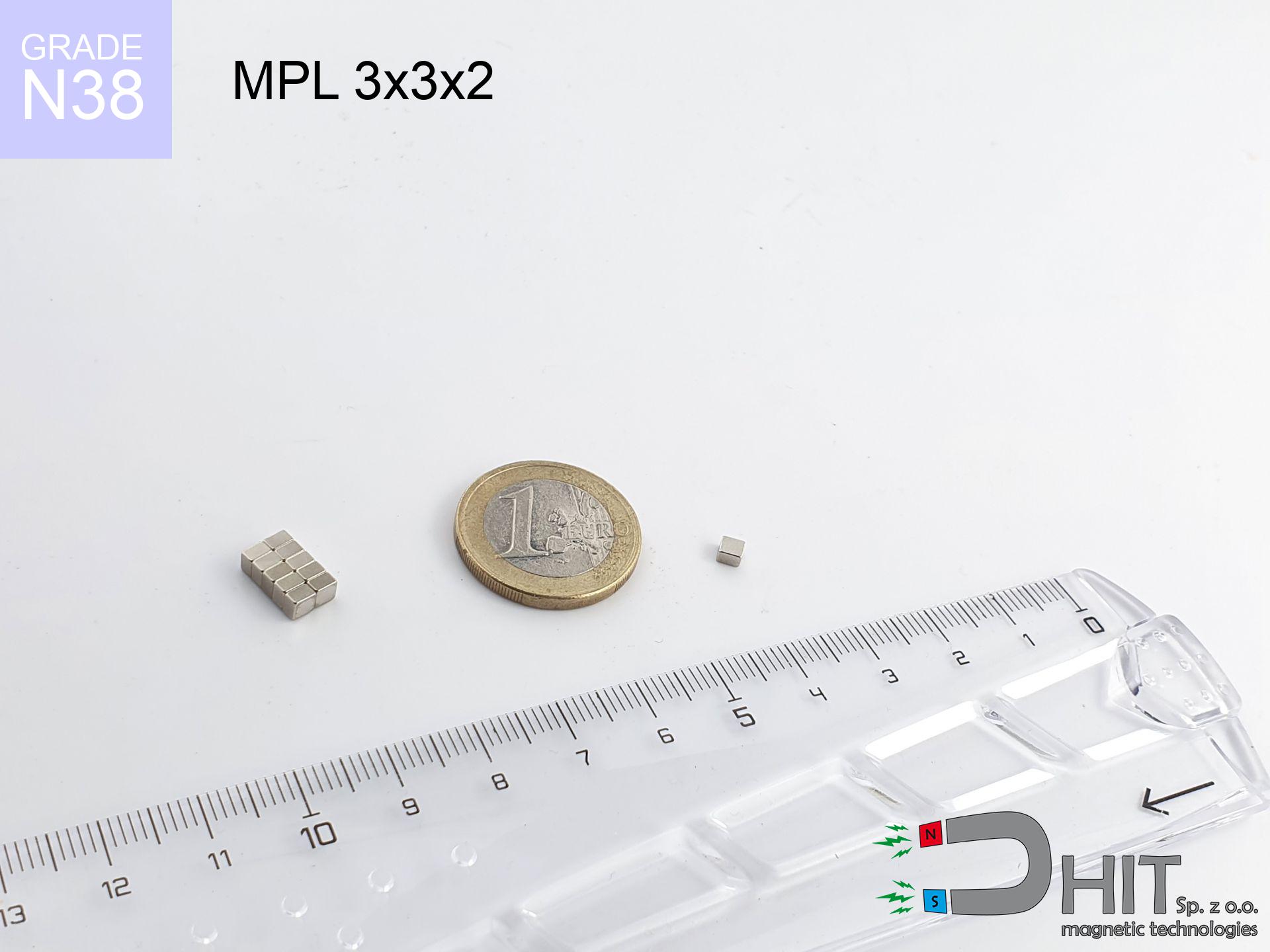MW 25x2.5 / N38 - neodymium magnet
cylindrical magnet
catalog number 010449
GTIN: 5906301811121
diameter Ø
25
mm [±0,1 mm]
height
2.5
mm [±0,1 mm]
magnetizing direction
↑ axial
capacity ~
3.46 kg / 33.93 N
magnetic induction ~
121.57 mT / 1,216 Gs
max. temperature
≤ 80
°C
catalog number 010449
GTIN: 5906301811121
diameter Ø
25 mm [±0,1 mm]
height
2.5 mm [±0,1 mm]
magnetizing direction
↑ axial
capacity ~
3.46 kg / 33.93 N
magnetic induction ~
121.57 mT / 1,216 Gs
max. temperature
≤ 80 °C
4.30 ZŁ gross price (including VAT) / pcs +
3.50 ZŁ net price + 23% VAT / pcs
bulk discounts:
need more quantity?Want a better price?
Call us tel: +48 22 499 98 98 or contact us via form on our website. You can check the mass and the appearance of neodymium magnets in our power calculator power calculator
Orders placed by 2:00 PM will be shipped on the same business day.
Specification: cylindrical magnet 25x2.5 / N38 ↑ axial
Magnetic properties of the material N38
Physical properties of sintered neodymium magnets Nd2Fe14B
Moreover, although neodymium is part of the strongest magnets, they are prone to corrosion in humid environments. Therefore, they are coated with a coating of gold-nickel to increase their durability. Interestingly that NdFeB neodymium magnets are about 13% lighter than SmCo magnets and, despite their power, are brittle, which requires special caution during their handling. For this reason, any mechanical processing should be done before they are magnetized.
In terms of safety, there are several recommendations regarding the use of these magnets. They should not be used in acidic, basic, organic environments or in solvents, and also in water or oil. Additionally, they can distort data on magnetic cards and hard drives, although data deletion using a neodymium magnet is not guaranteed.
In terms of properties in different environments, neodymium magnets are sensitive to corrosion, especially in humid conditions. Therefore, they are often coated with thin coatings, such as silver, to shield them from external factors and prolong their durability. Temperatures exceeding 130°C can cause a loss of their magnetic properties, although there are particular types of neodymium magnets that can withstand temperatures up to 230°C.
As for risks, it is important to avoid using neodymium magnets in acidic environments, basic environments, organic or solvent environments, unless they are adequately insulated. Additionally, their use is not recommended in wet conditions, oil, or in an atmosphere containing hydrogen, as they may lose their magnetic properties.
Compilation of suggested goods
Advantages and disadvantages of neodymium magnets NdFeB.
In addition to immense strength, neodymium magnets have the following advantages:
- They do not lose strength over time - after 10 years, their strength decreases by only ~1% (theoretically),
- They are highly resistant to demagnetization by external magnetic field,
- In other words, thanks to the glossy nickel, gold, or silver finish, the element gains an aesthetic appearance,
- They have very high magnetic induction on the surface of the magnet,
- By using an appropriate combination of materials, they can achieve significant thermal resistance, allowing them to operate at temperatures up to 230°C and above...
- The ability for precise shaping and customization to specific needs – neodymium magnets can be produced in many variants of shapes or sizes, which enhances their versatility in applications.
- Significant importance in modern technologies – are utilized in computer drives, electric motors, medical devices and very modern machines.
Disadvantages of neodymium magnets:
- They are prone to breaking as they are fragile when subjected to a strong impact. If the magnets are exposed to impacts, we recommend using magnets in a steel housing. The steel housing in the form of a holder protects the magnet from impacts and simultaneously increases its overall strength,
- High temperatures can reduce the power of neodymium magnets. Typically, after heating above 80°C, most of them experience a permanent loss in strength (although it is dependent on the shape and size). To prevent this, we offer special magnets marked with the symbol [AH], which are highly resistant to high temperatures. They can operate even at temperatures up to 230°C, making them an ideal solution for applications requiring high-temperature operation,
- They rust in a humid environment - during outdoor use, we recommend using waterproof magnets, such as those made of rubber or plastic,
- Limited ability to create threads or complex shapes in the magnet - the use of a housing is recommended - magnetic holder
- Possible danger to health from tiny fragments of magnets are risky, when accidentally ingested, which is crucial in the context of children's health. It's also worth noting that tiny parts of these products have the potential to be problematic in medical diagnosis after entering the body.
Handle with Care: Neodymium Magnets
Dust and powder from neodymium magnets are flammable.
Do not attempt to drill into neodymium magnets. Mechanical processing is also not recommended. Once crushed into fine powder or dust, this material becomes highly flammable.
Neodymium magnets should not be near people with pacemakers.
Neodymium magnets produce strong magnetic fields that can interfere with the operation of a heart pacemaker. Even if the magnetic field does not affect the device, it can damage its components or deactivate the entire device.
The magnet is coated with nickel. Therefore, exercise caution if you have an allergy.
Studies clearly indicate a small percentage of people who suffer from metal allergies such as nickel. An allergic reaction often manifests as skin redness and rash. If you have a nickel allergy, try wearing gloves or avoid direct contact with nickel-plated neodymium magnets.
Neodymium magnets are noted for their fragility, which can cause them to become damaged.
In the event of a collision between two neodymium magnets, it can result in them getting chipped. They are coated with a shiny nickel plating similar to steel, but they are not as hard. At the moment of connection between the magnets, small sharp metal fragments can be propelled in various directions at high speed. Eye protection is recommended.
Keep neodymium magnets away from the wallet, computer, and TV.
Neodymium magnets produce strong magnetic fields that can destroy magnetic media such as floppy disks, video tapes, HDDs, credit cards, magnetic ID cards, cassette tapes, or other devices. They can also damage videos, televisions, CRT computer monitors. Do not forget to keep neodymium magnets at a safe distance from these electronic devices.
Neodymium magnets are the strongest magnets ever invented. Their strength can shock you.
Familiarize yourself with our information to properly handle these magnets and avoid significant swellings to your body and prevent damage to the magnets.
Neodymium Magnets can attract to each other, pinch the skin, and cause significant swellings.
Magnets will attract each other within a distance of several to around 10 cm from each other. Don't put your fingers in the path of magnet attraction, as a serious injury may occur. Magnets, depending on their size, are able even cut off a finger or alternatively there can be a serious pressure or even a fracture.
Do not give neodymium magnets to children.
Neodymium magnets are not toys. You cannot allow them to become toys for children. In such a situation, surgery is necessary to remove them. In the worst case scenario, it can result in death.
Neodymium magnets can become demagnetized at high temperatures.
While Neodymium magnets can demagnetize at high temperatures, it's important to note that the extent of this effect can vary based on factors such as the magnet's material, shape, and intended application.
Under no circumstances should neodymium magnets be brought close to GPS and smartphones.
Neodymium magnets generate strong magnetic fields that interfere with magnetometers and compasses used in navigation, as well as internal compasses of smartphones and GPS devices.
So you are aware of why neodymium magnets are so dangerous, see the article titled How dangerous are very strong neodymium magnets?.







